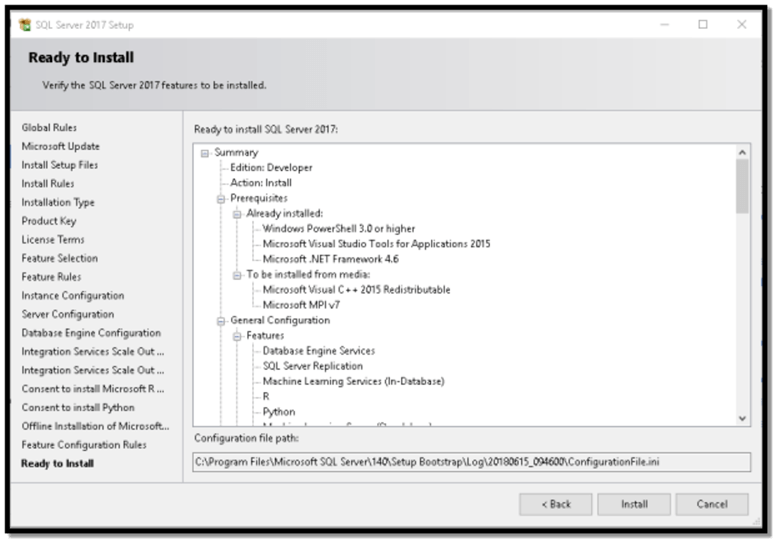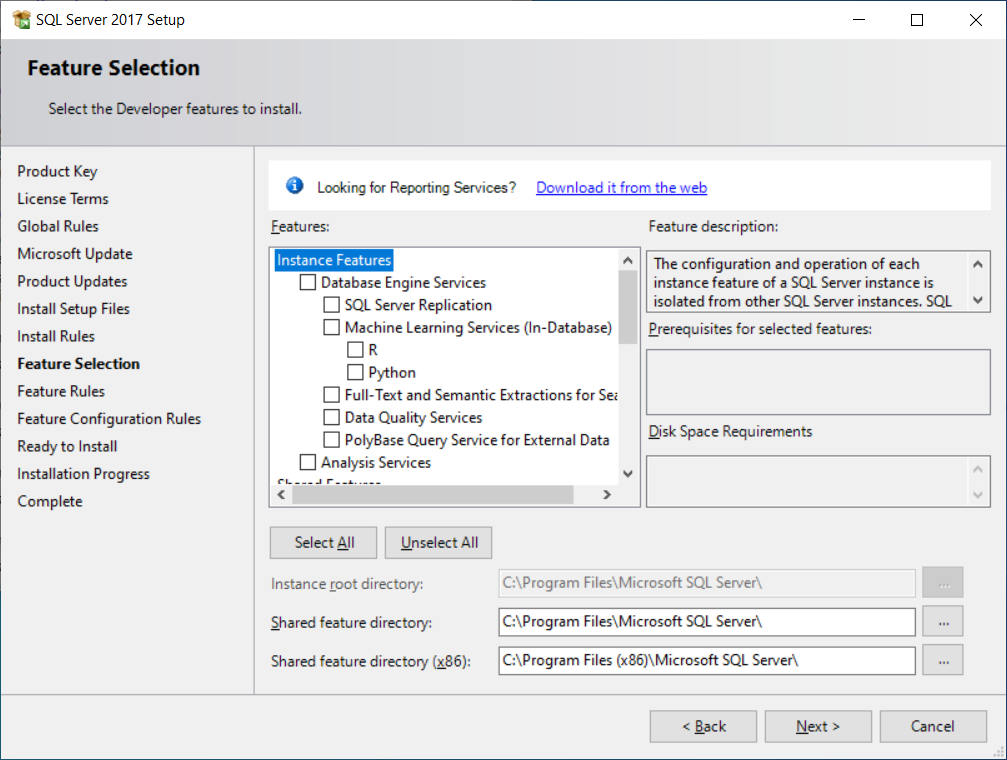

- SQL SERVER 2017 DEVELOPER EDITION REQUIREMENTS HOW TO
- SQL SERVER 2017 DEVELOPER EDITION REQUIREMENTS INSTALL
- SQL SERVER 2017 DEVELOPER EDITION REQUIREMENTS WINDOWS
Do not use the local machine service account. Your account that runs SQL Services must be a domain account.
SQL SERVER 2017 DEVELOPER EDITION REQUIREMENTS HOW TO
Here is instructions on how to do that: (v=sql.110).aspx If you have more than one instance on your server, you will need to create an additional endpoint so the instances can communicate with each other.

Each instance needs a database mirroring endpoint. This is not supported with AlwaysOn.ĭatabase Mirroring Endpoint. No replicas can run Active Directory services. All replicas in your AlwaysOn group must use the same SQL Server collation.Īctive Directory Services. Databases in your AlwaysOn group must use the same collation…they cannot differ across replicas. Standard edition will not work.ĭatabase Collation.
SQL SERVER 2017 DEVELOPER EDITION REQUIREMENTS INSTALL
For testing or development purposes, you can install Developer or Evaluation edition, but for a production environment, you must install Enterprise edition. SQL Server 2012 or 2014 Enterprise Edition. So be very familiar with your workload, and try and make sure your replicas are equally yoked. Your AlwaysOn group is only as fast and strong as your weakest link. So your primary will only operate as fast as your slowest secondary. But it will also be slower if you don’t fail over! That’s because the primary sends transactions to the secondary, and with synchronous data replication, the primary has to wait for the secondary to harden the log before it can move on to the next task. It will be slower performance if you have to fail over. If you’re thinking that “we’ll use our good, powerful server as the primary replica, and use the slower, weaker server as a secondary” with the thought that if we do have to fail over, we will just know up front that the performance will be a little slower while we get the primary server back up and running… well guess what. Again, you don’t have to have identical hardware on each of your replicas, but you need to have sufficient resources on your secondaries to handle the same workload as your primary. And if you have other databases on your secondary replicas that are not part of your AlwaysOn group, your disk space must account for the size and growth of those databases as well. As your databases on the primary replica grow, the replicated databases on your secondaries will also grow the same amount. You don’t have to have identical hardware on each replica, but you do need enough disk space to hold all of your databases, and to account for the growth of those databases.

SQL SERVER 2017 DEVELOPER EDITION REQUIREMENTS WINDOWS
Most likely you will need to adjust your Windows Firewall setting to allow the replicas to communicate with each other. AlwaysOn groups are not supported on a domain controller.

None of your replicas can be a domain controller. They must be able to communicate with each other. All replicas in your AlwaysOn group must be in the same windows domain. Here is a list of the available hotfixes at this time: (v=sql.110).aspx#WinHotfixes Again, it is strongly recommended that you use Windows Server 2012 on all of your replicas instead. This is particularly important if you are using Windows Server 2008R2, as most of the hotfixes are aimed toward that version. You need to install all available windows hotfixes on every replica prior to deploying AlwaysOn. This can be installed at the same time you install your Windows Failover Cluster (via Server Manager > Add Roles & Features > Add Failover Clustering): net 3.5.1 or greater is not already installed on your primary and secondary replicas, you will need to install this. Īnd each SQL Server that hosts an availability group replica must reside on separate nodes of a single WSFC cluster. This is done through Server Manager > Add Roles & Features > Add Failover Clustering. WSFC must be installed on every replica (primary and secondaries) in the AlwaysOn group. Click here for a more in-depth explanation: However, it is strongly recommended that you use Windows Server 2012 instead, as there are many issues and headaches associated with 2008R2. Windows Server 2008R2 is the minimum Windows Server edition allowed for deploying AlwaysOn. These prerequisites focus on your Windows environment, the SQL instances, and the databases to be included in your AlwaysOn group. There are several prerequisites that need to be done to ensure a successful deployment. Before implementing your AlwaysOn Availability Group, make sure you have everything in your environment ready to go.


 0 kommentar(er)
0 kommentar(er)
